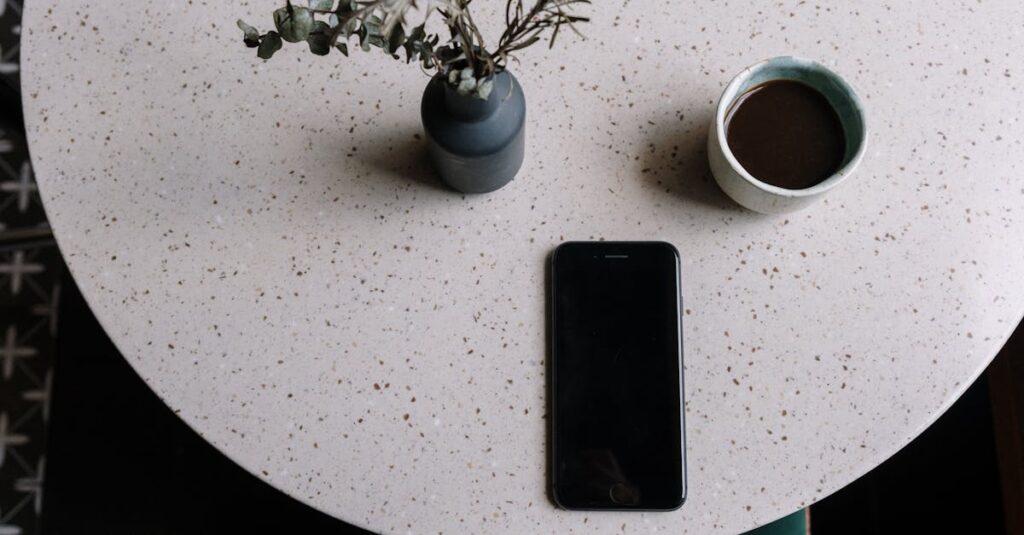Table of Contents
ToggleEver tried to show off that hilarious cat video on your big screen only to find yourself lost in the digital jungle of your iPhone? You’re not alone. Many users find themselves scratching their heads wondering, “Why can’t I find screen mirroring on my iPhone?” It’s like searching for a needle in a haystack, except the needle is a feature that should be right at their fingertips.
Understanding Screen Mirroring
Screen mirroring allows users to project their iPhone display onto a larger screen. This feature makes it simple to share content, like videos or presentations, with friends or in professional settings.
What Is Screen Mirroring?
Screen mirroring refers to the technology that displays the content of an iPhone screen on a compatible device. Users can connect their iPhones to smart TVs, projectors, or compatible computers without using cables. Often, the connection occurs through Wi-Fi, ensuring a wireless experience. Applying this technology enhances the ability to share media effortlessly during gatherings or meetings.
Benefits of Screen Mirroring on iPhone
Screen mirroring provides several advantages for iPhone users. First, users can enjoy videos, games, or photos on a larger display, improving overall viewing experiences. Second, it facilitates group activities, such as watching movies with friends, making it more interactive. Third, screen mirroring enhances presentations, allowing users to share slides and documents easily. Finally, it supports remote collaboration, enabling seamless connectivity during virtual meetings.
Common Reasons for Missing Screen Mirroring
Several reasons might explain why screen mirroring isn’t showing up on an iPhone. Understanding these common issues can help users troubleshoot effectively.
Compatibility Issues
Not all devices support screen mirroring. Older iPhone models may lack this feature. Furthermore, the target device, such as a smart TV or projector, must be compatible with Apple’s AirPlay technology. Popular brands may have built-in support, while others may require additional adapters. He or she should check the manufacturer’s specifications for their devices. Using compatible devices ensures a smoother connection and a better mirroring experience.
Software Updates
Running outdated software can hinder the screen mirroring feature. iPhones regularly receive updates that improve functionality and fix bugs. To access the latest features, it’s vital to keep the iPhone’s operating system current. Checking for software updates can be as simple as navigating to Settings, then General, and tapping on Software Update. Users should also verify that the target device is up to date. Keeping both devices updated enhances compatibility and performance.
Troubleshooting Steps
To locate the screen mirroring feature, users can follow these steps to troubleshoot common issues.
Restart Your iPhone
Restarting the device often resolves temporary glitches. Press and hold the side button and either volume button until the slider appears. After dragging the slider to power off, wait for about 30 seconds before restarting. This simple action refreshes the iOS, sometimes making the screen mirroring option reappear.
Check AirPlay Settings
AirPlay settings must be enabled for screen mirroring to function. Access the Control Center by swiping down from the top-right corner of the screen. Look for the AirPlay icon, which resembles a rectangle with a triangle at the bottom. If it’s grayed out, AirPlay might not be enabled on the target device or network. Ensure that the destination device supports AirPlay and is turned on.
Ensure Wi-Fi Connection
A stable Wi-Fi connection is essential for successful screen mirroring. Check the Wi-Fi settings on the iPhone to ensure it connects to the correct network. Both the iPhone and the receiving device need to be on the same Wi-Fi network. Weak signals can cause disruptions, so moving closer to the router might improve connectivity.
Alternative Solutions
Various options exist for users unable to find the screen mirroring feature on their iPhones. Exploring third-party apps and wired connections can enhance the mirroring experience.
Using Third-Party Apps
Several third-party applications provide screen mirroring functions for iPhones. Apps like Reflector and AirServer enable users to project their displays seamlessly onto larger screens. Selecting an app requires checking compatibility with specific devices before installation. Most of these apps feature user-friendly interfaces, simplifying the mirroring process. In most cases, users need to connect their iPhones and target devices to the same Wi-Fi network for optimal performance. Using these alternatives may solve issues related to missing native features or compatibility.
Exploring Wired Connections
Another effective method involves using wired connections for screen mirroring. Adapters like the Lightning Digital AV Adapter connect directly to the iPhone. With an HDMI cable, users can link their phones to compatible displays. This setup provides a stable connection, ensuring high-quality video and audio transmission. Checking device compatibility remains essential before purchasing any adapter. Using wired connections eliminates reliance on Wi-Fi stability, delivering a reliable mirroring experience.
Finding the screen mirroring feature on an iPhone can be a challenge but understanding the potential obstacles makes the process smoother. By ensuring compatibility and keeping devices updated users can significantly improve their chances of success.
If issues persist troubleshooting steps like restarting the device or checking AirPlay settings can help. For those still struggling alternative methods such as third-party apps or wired connections offer viable solutions.
With the right approach users can enjoy seamless screen mirroring and enhance their viewing experiences.







